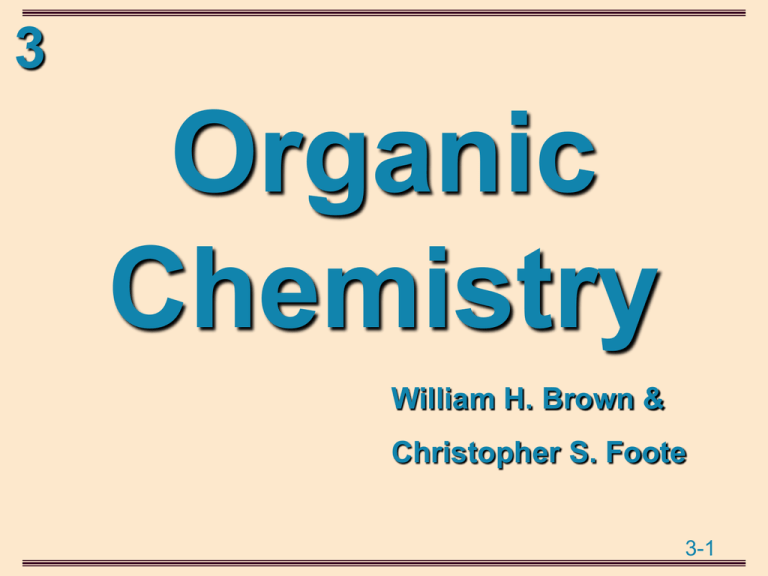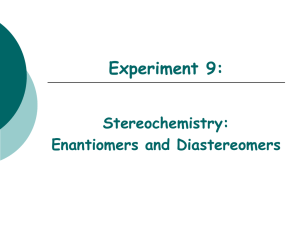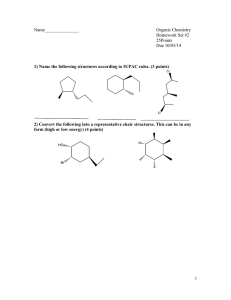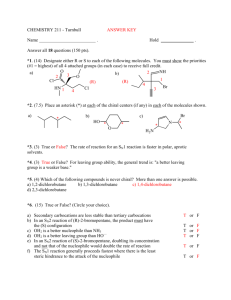(a)? 3
advertisement

3 Organic Chemistry William H. Brown & Christopher S. Foote 3-1 3 Chirality Chapter 3 3-2 3 Isomers Isomers: different compounds with the same molecular formula Constitutional isomers: isomers with a different connectivity Stereoisomers: isomers with the same molecular formula and connectivity but a different orientation of their atoms in space 3-3 3 Isomers Compounds with the same molecular formula rotation about a single bond same different connectivity connectivity Stereoisomers without stereocenters Chiral Achiral Enantiomers Cis,Trans (E,Z) Isomers Constitutional Isomers Conformations rotation restricted Conformational Isomers with stereocenters Chiral Enantiomers Diastereomers Achiral Meso Compounds 3-4 3 Chirality Mirror image: the reflection of an object in a mirror Chiral: an object that is not superposable on its mirror image; an object that shows handedness Achiral: an object that lacks chirality; an object that has no handedness • an achiral object has at least one element of symmetry 3-5 3 Elements of Symmetry Plane of symmetry: an imaginary plane passing through an object dividing it so that one half is the mirror image of the other half H Br C Cl H 3-6 3 Elements of Symmetry Plane of symmetry (contd.) mirror plane HO OH 3-7 3 Elements of Symmetry Center of symmetry: a point so situated that identical components of the object are located on opposite sides and equidistant from the point along any axis passing through it Br H Cl Cl H Br center of symmetry 3-8 3 Stereocenter The most common (but not the only) cause of chirality in organic molecules is a tetrahedral atom, most commonly carbon, bonded to four different groups A carbon with four different groups bonded to it is called a stereocenter or, alternatively, a stereogenic center 3-9 3 Enantiomers Enantiomers: stereoisomers that are nonsuperposable mirror images; refers to the relationship between pairs of objects On the three following screens are examples chiral molecules. Each has one stereocenter and can exist as a pair of enantiomers. 3-10 3 Enantiomers Lactic acid HO HO O O OH C C C C H CH3 H H3 C OH 3-11 3 Enantiomers 2-Chlorobutane H Cl Cl CH3 CHCH2 CH3 Cl H 3-12 3 Enantiomers Cl 3-Chlorocyclohexene Cl H Cl H 3-13 3 Enantiomers A nitrogen stereocenter + + N H3 C N CH2 CH3 CH3 CH2 CH3 A pair of enantiomers 3-14 3 R,S Convention Priority rules 1. Each atom bonded to the stereocenter is assigned a priority based on atomic number; the higher the atomic number, the higher the priority (1) (6) -H -CH3 (7) -N H2 (8) (16) (17) - OH - SH - Cl (35) (53) - Br -I Increasing priority 2. If priority cannot be assigned per the atoms bonded to the stereocenter, look to the next set of atoms; priority is assigned at the first point of difference (1) - CH 2 -H (6) - CH 2 -CH 3 (7) - CH 2 -NH2 (8) - CH 2 -OH Increasing priority 3-15 3 R,S Convention 3. Atoms participating in a double or triple bond are considered to be bonded to an equivalent number of similar atoms by single bonds - CH = CH 2 O - CH is treated as is treated as C C - CH -CH2 O C C O H 3-16 3 Naming Enantiomers 1. Locate the stereocenter, identify its four substituents, and assign priority from 1 (highest) to 4 (lowest) to each substituent 2. Orient the molecule so that the group of lowest priority (4) is directed away from you 3. Read the three groups projecting toward you in order from highest (1) to lowest priority (3) 4. If the groups are read clockwise, the configuration is R; if they are read counterclockwise, the configuration is S (S)-2-Chlorobutane H Cl S 2 1 3 3-17 3 R,S Configuration • (R)-3-Chlorocyclohexene 3 Cl 1 2 H R • (R)-Mevalonic acid 1 1 4 HO CH3 O HO 3 2 R OH 3 2 3-18 3 Enantiomers & Diastereomers a molecule with 1 stereocenter, 21 = 2 stereoisomers are possible For a molecule with 2 stereocenters, a maximum of 22 = 4 stereoisomers are possible For a molecule with n stereocenters, a maximum of 2n stereoisomers are possible For 3-19 3 Enantiomers & Diastereomers 2,3,4-trihydroxybutanal • two stereocenters; 22 = 4 stereoisomers exist CHO CHO H C OH HO C H H C OH HO C H CH2 OH CH2 OH A pair of enantiomers (Erythreose) CHO CHO H C OH HO C H HO C H C OH CH2 OH H CH2 OH A pair of enantiomers (Threose) 3-20 3 Enantiomers & Diastereomers 2,3-dihydroxybutanedioic acid (tartaric acid) • two stereocenters; 2n = 4, but for this molecule, only three stereoisomers exist COOH COOH H C OH HO C H H C OH HO C H COOH COOH A meso compound (plane of symmetry) COOH COOH H C OH HO C H HO C H C OH H COOH COOH A pair of enantiomers Meso compound: an achiral compound possessing two or more stereocenters 3-21 3 Enantiomers & Diastereomers 2-methylcyclopentanol CH 3 OH HO H 3 C H H H H cis-2-Methylcyclopentanol (a pair of enantiomers) CH3 H diastereomers H H3 C H OH H HO trans-2-Methylcyclopentanol (a pair of enantiomers) 3-22 3 Enantiomers & Diastereomers 1,2-cyclopentanediol OH HO H OH HO H H H cis- 1,2-Cyclopentanediol (a meso compound) OH H H diastereomers HO OH H H HO trans- 1,2-Cyclopentanediol (a pair of enantiomers) 3-23 3 Enantiomers & Diastereomers cis-3-methylcyclohexanol H3 C OH HO CH3 3-24 3 Enantiomers & Diastereomers trans-3-methylcyclohexanol H3 C CH3 OH HO 3-25 3 Properties of Stereoisomers Enantiomers have identical physical and chemical properties in achiral environments Diastereomers are different compounds and have different physical and chemical properties Meso-tartaric acid, for example, has different physical and chemical properties from its enantiomers (see Table 3.1). 3-26 3 Plane-Polarized Light Ordinary light: light vibrating in all planes perpendicular to its direction of propagation Plane-polarized light: light vibrating only in parallel planes • plane polarized light is the vector sum of left and right circularly polarized light; these two forms of light are enantiomers • because of their handedness, each component of circularly polarized light interacts in an opposite way with a chiral molecule. 3-27 3 Plane-Polarized Light QuickTime™ and a Photo - JPEG decompressor are needed to see this picture. 3-28 3 Plane-Polarized Light • because of its handedness, circularly polarized light reacts one way with an R stereocenter, and in an opposite with its enantiomer • the net effect of the interaction of plane polarized light with a chiral compound is that the plane of polarization is rotated Polarimeter: a device for measuring the extent of rotation of plane polarized light 3-29 3 Optical Activity rotation: the number of degrees, , through which a compound rotates the plane of polarized light Dextrorotatory (+): refers to a compound that rotates the plane of polarized light to the right Levorotatory (-): refers to a compound that rotates of the plane of polarized light to the left Observed 3-30 3 Optical Activity Specific rotation: observed rotation of the plane of polarized light when a sample is placed in a tube 1.0 dm in length and at a concentration of 1g/mL T observed rotation (degrees) [] Specific rotation = = length (dm) x concentration (g/mL) 3-31 3 Optical Activity For a pair of enantiomers, the value of the specific rotation of each is the same, but opposite in sign OH HO C H CH3 CH2 C CH3 (S)-(+)-2-Butanol 25 [ ] D +13.52 H CH2 CH3 H3 C (R)-(-)-2-Butanol 25 [ ] D -13.52 3-32 3 Enantiomeric Excess When dealing with a mixture of enantiomers, it is essential to describe the composition of the mixture and the degree to which one enantiomer is in excess The most common designation is enantiomeric excess (ee) ee = [R] - [S] x 100 = %R - %S [R] + [S] 3-33 3 Enantiomeric Excess Example: a commercial synthesis of naproxen, a nonsteroidal antiinflammatory drug (NSAID), gives this enantiomer in 97% ee. Assign an R or S configuration to its stereocenter, and calculate the % R and S enantiomers in the mixture. H CH3 C H 3 CO COOH Naproxen 3-34 3 Resolution Racemic mixture: an equimolar mixture of two enantiomers • because a racemic mixture contains equal numbers of dextrorotatory and levorotatory molecules, its specific activity is zero. Resolution: the separation of a racemic mixture into its enantiomers 3-35 3 Resolution One means of resolution is to convert the pair of enantiomers into two diastereomers • diastereomers are different compounds and have different physical properties A common reaction for chemical resolution is salt formation + RCOOH :B (R,S)-Carboxylic (R')-Base acid - + RCOO HB (RR')-Salt + (SR')-Salt) • after separation of the diastereomers, the enantiomerically pure acids are recovered 3-36 3 Resolution Examples of enantiomerically pure bases H H H H H H N HO N HO H H CH3 O N (+)-Cinchonine [ ] 23 = +228 D N (-)-Quinine [ ] 25 = -165 D 3-37 3 QuickTime™ and a Photo - JPEG decompressor are needed to see this picture. 3-38 3 Resolution Enzymes as resolving agents O OCH2 CH3 C H CH3 H 3 CO Ethyl ester of (S)-naproxen 1. esterase N aOH, H2 O CH3 CH2 O + C O H H3 C OCH3 Ethyl ester of (R)-naproxen (not affected by the esterase) 2 . HCl, H2 O O OH C H CH3 H 3 CO (S)-Naproxen 3-39 3 Chirality in the Biological World Except for inorganic salts and a few lowmolecular-weight organic substances, the molecules of living systems are chiral Although these molecules can exist as a number of stereoisomers, generally only one is produced and used in a given biological system It’s a chiral world! 3-40 3 Chirality in the Biological World Consider chymotrypsin, a protein-digesting enzyme in the digestive system of animals • chymotrypsin contains 251 stereocenters • the maximum number of stereoisomers possible is 2251 • there are only 238 stars in our galaxy! 3-41 3 Chirality in the Biological World Enzymes are like hands in a handshake • the substrate fits into a binding site on the enzyme surface • a left-handed molecule will only fit into a left-handed binding site and • a right-handed molecule will only fit into a righthanded binding site • enantiomers have different physiological properties because of their handedness of their interactions with other chiral molecules in living systems 3-42 3 Chirality in the Biological World QuickTime™ and a Photo - JPEG decompressor are needed to see this picture. 3-43 3 Prob 3.15 Draw mirror images for each molecule. CHO OH (a) H3 C H (d) (b) H C COOH O C OH (e) C H CH 3 H OH OH (f) OH CH 3 CH 3 OH CH 3 (c) H 2 N CH 2 OH H (g) COOH (h) H H OH CH 3 OH 3-44 3 Prob 3.16 Which are identical with (a) and which are mirror images of (a)? COOH (a) H H3 C CH3 (b) C OH HO H OOC HO H (d) C CH3 H CH3 COOH (c) C H HO C COOH 3-45 3 Prob 3.17 Mark all stereocenters in each molecule. CH3 (a) CH3 CCH= CH2 OH O (d) CH3 CCH2 CH 3 COOH (b) HCOH CH3 CH2 OH (e) HCOH CH2 OH CH3 (c) CH3 CHCH COOH N H2 OH (f) CH3 CH2 CHCH= CH2 CH2 COOH (g) HOCCOOH CH2 COOH 3-46 3 Prob 3.20 Assign an R or S configuration to the stereocenter in each enantiomer. CH3 CH3 O C H H2 C CH3 O (-)-Carvone C CH 2 CH3 (+)-Carvone [ ] D -62.5° [ ] 20 Spearmint oil H 20 D +62.5° Caraway and dill seed oil 3-47 3 Prob 3.21 Assign an R or S configuration to this enantiomer of 2butanol. Also draw a Newman production viewed along the bond between carbons 2 and 3. H3 C H H H OH CH3 3-48 3 Prob 3.22 Assign an R or S configuration to each stereocenter in this enantiomer of ephedrine. H C HO H NH CH 3 C CH3 Ephedrine [ ] 21 D -41° 3-49 3 Prob 3.23 Assign an R or S configuration to this enantiomer of carbon-14 labeled citric acid. O C-COOH CH2 COOH Oxaloacetic acid + O CH3 CSCoA 14 Acetyl-CoA citrate synthase 14 CH2 COOH H OOC C OH CH2 COOH [2-14 C]Citric acid 3-50 3 Prob 3.24 Draw all stereoisomers possible for this compound. Label which are meso and which are pairs of enantiomers. H3 C H OOC CH 3 COOH 3-51 3 Prob 3.25 Mark are stereocenters in each molecule. How many stereoisomers are possible for each molecule? OH CH2 - COOH (a) CH3 CHCH COOH HO OH OH (d) (e) O (g) (b) CH- COOH HO CH- COOH OH (f) O (c) COOH (h) O OH 3-52 3 Prob 3.26 Label the eight stereocenters in cholesterol. HO 3-53 3 Prob 3.27 Label the four stereocenters in amoxicillin. HO O CH- C H N NH 2 S N O HO CH3 CH3 C O 3-54 3 Prob 3.29 Are the formulas in each set identical, enantiomers, or diastereomers? Cl H Cl H (a) and H OH HO H H Cl HO H (b) and H OH H Cl H Cl (c) HO H and HO H Cl H 3-55 3 Prob 3.30 Which are meso compounds? Br (a) Br Br C H CH 3 (b) C C H CH3 H CH3 CH3 OH CH3 OH (c) OH Br CH2 OH CH3 OH OH (d) H CH 3 C (f) (e) H OH H OH OH CHO (g) H H OH OH CH2 OH (h) HO H CH2 OH H OH CH2 OH CH2 OH H (i) H CH 2 OH OH OH CH 2 OH 3-56 3 Prob 3.31 Oxidation of this bicyclic alkene gives a dicarboxylic acid. Is the product of this oxidation one enantiomer, a racemic mixture, or a meso compound? vigorous oxidation H OOC COOH 3-57 3 Prob 3.35 Verify that although, this molecule has no stereocenter, it is chiral. O O 3-58 3 Prob 3.36 Verify that, although this substituted allene has no stereocenter, it is chiral. H H C C C C( CH3 ) 3 ( CH3 ) 3 C [] 25 D -314 3-59 3 Chirality End of Chapter 3 3-60






